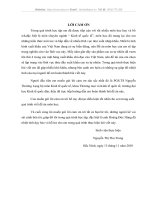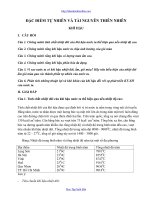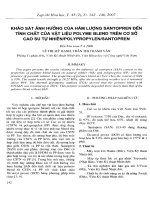Tài liệu cao su tự nhiên
Bạn đang xem bản rút gọn của tài liệu. Xem và tải ngay bản đầy đủ của tài liệu tại đây (1.25 MB, 10 trang )
Downloaded from
AGING OF NATURAL RUBBER IN AIR AND SEAWATER
P. H. Mott, C. M. Roland*
Code 6120, Naval Research Laboratory, Washington DC 20375
ABSTRACT
Accelerated aging experiments were carried out on a natural rubber vulcanizate exposed to air and to seawater. Failure
strain, shown to correlate well with the fatigue lifetime, was used to monitor the extent of degradation. The effect of
temperature on the rate of aging followed an Arrhenius law, with activation energies equal to 90 ± 4 and 63 ± 3 kJ/mol for
air and seawater aging, respectively. The difference can be accounted for by the difference in oxygen concentration for the
two environments.
INTRODUCTION
To predict the service life of a rubber component subjected to a variety of environments, it is necessary to account for all modes of degradation. This can be difficult in a complex environment such
as seawater, where different processes, such as oxidation, swelling, leaching, and even biodegradation, may occur simultaneously. The present study was motivated by the Navy’s development
of an elastomeric disk as potentially the torpedo launcher on future Virginia-class submarines.1
The development of the rubber compound has been described previously.2 The disk has a diameter
of more than 2 m and a thickness varying from 20 to 30 cm. It is to be inflated with seawater to
100% biaxial strain, and the performance must be maintained over roughly 2000 inflation cycles
(ca. 15 years). Since any degradation of the mechanical properties will impair a vital function of
the submarine, a reliable assessment of longevity is crucial.
An obvious method for lifetime prediction is to accelerate the aging, so that deterioration of
properties occurs over a feasible time scale, e.g., a few weeks. The Arrhenius equation3 is then
used to predict the degradation rate at the service temperature:
Ea
r1
= A exp −
r2
R
1
1
−
T1
T2
(1)
where r1 is the reaction rate at temperature T1 , etc., A is a constant, and Ea is the activation energy.
Extrapolation of short time, high temperature data in this manner to yield lifetime estimates for
rubber exposed to long times at lower temperatures has a long history.4−9 Herein, our emphasis is
on the material properties that affect the stored energy and the fatigue lifetime, since these directly
influence the performance of an elastomeric torpedo launcher.
EXPERIMENTAL
The rubber formulation is listed in Table I. To insure repeatability, all samples were obtained
from a single batch. Test sheets, 120- × 65- × 1.5-mm, were cured 30 min at 160 ◦ C, followed by
exposure to the various aging environments. Air degradation was carried out in a convection oven
(Delta 9023). Seawater aging was performed in vented, enclosed tanks, equipped with temperature
controllers and circulators. The brine was prepared by dissolving a commercial preparation (Aquarium Systems Instant Ocean R ) into distilled water, at a concentration of 3.5%, as determined from
* Corresponding author. Tel: 202-767-1719; fax: 202-767-0594; e-mail:
79
80
RUBBER CHEMISTRY AND TECHNOLOGY
Vol. 74
Table I
Rubber Compound
Ingredient
Deproteinized NR
Zinc oxide
Zinc di-2-ethylhexoate
Diphenylamine-acetone
Zinc 2-mercaptotoluimidazole
n-t-Butyl-2-benzothiazolesulfenimide
Sulfur
Processing aid
n-(Cyclohexythoiphthalimide)
NaO3 SS(CH2 )6 Na-H2 O
N110 carbon black
N550 carbon black
Trade Name
DP-CV
Zinc oxide RG-MA
Octate Z
AgeRite R Superflex Solid G
Vanox R ZMTI
Santocure R TBSI
Sulfur RM
Vanfre R AP2
Vantard R PVI
Duralink R HTS
Corax R N110
Corax R N550
Source
H.A. Astlett Co.
Akrochem Corp.
R. T. Vanderbilt Co.
R. T. Vanderbilt Co.
R. T. Vanderbilt Co.
Monsanto Chemical Co.
Akrochem Corp.
R. T. Vanderbilt Co.
R. T. Vanderbilt Co.
Monsanto Chemical Co.
Degussa-Hüls Corp.
Degussa-Hüls Corp.
phr
100
3.0
1.5
1
0.5
1.0
2.5
3.0
0.5
2.0
10
40
the density. Dissolved oxygen concentrations were determined by the indigo-carmine method10
(ASTM D 888-87) using a commercial test kit (Chemets).
After aging, specimens were cut from the sheets for room-temperature stress–strain measurements (Instron 4206 with Wallace optical extensometer). Cyclic strain energies were measured at a
crosshead strain rate of 1.0 min−1 , with a maximum extension of 1.0; data from the third cycle was
utilized. Elongation to failure was carried out at an extension rate of 7.5 min−1 , with a minimum of
seven specimens tested for each condition. Fatigue testing employed a modified Monsanto Fatigue
Fig. 1. — Representative elongation to failure curves for the rubber unaged, seawater aged (328.2 h at 98 ◦ C)
and air aged (44.8 h at 120 ◦ C).
AGING OF NATURAL RUBBER
81
to Failure apparatus (ASTM D 4482-85), testing 12 samples per exposure condition at an elongation
of 1.26.
Thermogravimetic analysis (TGA) was carried out using a Perkin-Elmer TGA-7 with flowing
air.
RESULTS AND DISCUSSION
ELASTIC PROPERTIES
Figure 1 illustrates the effect of aging on the stress–strain curve for the rubber. There is a substantial decrease in the failure strain, along with an increase in modulus. Air aging consistently
caused the modulus to increase with time at all temperatures, although at the highest aging temperature (120 ◦ C) the increase was no more than 50%. The consequences of seawater aging were less
marked, with changes in the stress–strain curve discernible above the experimental scatter only for
longer exposure times.
FAILURE PROPERTIES
The failure properties decline with the extent of aging, as shown in Figure 2 (air exposure)
and Figure 3 (seawater exposure). Similarly, the fatigue life, measured after air aging at 110 ◦ C,
decreases with aging time (Figure 4).
Fig. 2. — Effect of air aging at the indicated temperatures on elongation at break and tensile strength.
82
RUBBER CHEMISTRY AND TECHNOLOGY
Vol. 74
Fig. 3. — Effect of seawater aging at the indicated temperatures on elongation at break and tensile strength.
Fig. 4. — Fatigue life after air aging at 110 ◦ C as a function of exposure time.
AGING OF NATURAL RUBBER
83
Usually, the failure of rubber in tension is interpreted using fracture mechanics, where the
number of cycles, N, depends on the strain energy, W , as11,12
N=
1
β−1
(β − 1)B(2KW )β c0
(2)
in which c0 is the intrinsic flaw size, and B and β are material constants. The parameter K is a
slowly varying function of strain13
π
K=√
λ
(3)
where λ is the stretch ratio.
Equation (2) can be used to relate the tensile fatigue life to the breaking strain for a given
material, but aging induces chemical changes. The cut growth properties (i.e., B and β), and also
the strain energy for a given λ change with aging. Nevertheless, the fatigue life of aged samples
correlates well with their failure strain (Figure 5). This means that we can use Equation (2) to relate
failure strain to fatigue life.
In Figure 6 is shown a double logarithmic plot of the fatigue life as a function of the ratio of
the strain energy parameter, KW in Equation (2), for N = 1 (single extension to break) to that for
fatigue testing at λ = 2.26; the exponent is 1.6. Note that if the changes in fatigue life were due only
to changes in strain energy (i.e., the material per se were unchanged), the slope of Figure 6 would
correspond to the β in Equation (2). For unfilled natural rubber (NR), β ≈ 2.14,15 The relationship
in Figure 6 is nearly quadratic, with at least some of the difference reflecting the changes in the
material itself.
Fig. 5. — Correlation of the fatigue life versus the elongation at break for air aging
at 110 ◦ C. Note the scales are both logarithmic.
84
RUBBER CHEMISTRY AND TECHNOLOGY
Vol. 74
Fig. 6. — Fatigue life versus the reciprocal of the strain energy parameter, normalized by the
strain energy for a single elongation to break.
TEMPERATURE DEPENDENCE OF AGING
The parallel curves for the failure strain in Figures 2 and 3 imply that a single aging mechanism
dominates over these temperatures. In Figure 7 are master curves for aging in air and in seawater,
Fig. 7. — Superpositioned “master” aging curves for air and seawater, at a reference temperature of 90 ◦ C.
AGING OF NATURAL RUBBER
85
constructed by shifting the data along the time axis, using a reference temperature of 90 ◦ C. The
two master curves are also parallel, again suggesting that the underlying degradation chemistry is
the same.
The shift factors used to construct Figure 7 are displayed in Figure 8 in the Arrhenius form,
yielding Ea = 90 ± 4 kJ/mol and 63 ± 3 kJ/mol for air and seawater, respectively. This activation
energy for air aging agrees with literature values for NR compounds obtained by various methods,
viz. 88 ≤ Ea ≤ 98 kJ/mol.16−18 Analyses based on puncture energy19 and surface chemistry20
yield somewhat lower values, ca. 75–80 kJ/mol.
OXYGEN SOLUBILITY
Although the aging curves in Figure 7 for the two environments are parallel, the activation
energy for seawater is significantly lower than for air. Thus, while the chemical mechanism of
rubber degradation may be the same, it is apparent that some other factor exerts an influence. The
obvious difference between the two media is the availability of oxygen. It is well known that the
solubility of oxygen in water decreases with temperature. This solubility is expressed by Henry’s
law21
PO2
(4)
xO2 =
k
in which xO2 is the mole fraction of dissolved oxygen, PO2 the partial pressure, and k a constant.
The temperature dependence of k contributes to the difference in aging behavior for rubber in air
versus seawater. Published data for various brine solutions22,23 can be interpolated to obtain a value
of k for seawater. The partial pressure of oxygen in seawater also varies with temperature, because
Fig. 8. — Horizontal shift factors used to construct the master curves in Figure 7. The slopes yield Ea = 90 and 63
kJ/mol for air and seawater aging, respectively. The dashed curve represents the data for seawater after factoring out the
temperature dependence of oxygen solubility.
86
RUBBER CHEMISTRY AND TECHNOLOGY
Vol. 74
in a closed vessel, it is being displaced. To estimate PO2 in our tank, the contribution of the water
vapor pressure, PH2 O , must be taken into account. Since air consists of 21% O2 ,
PO2 = 0.21
PT − PH2 O
PT
(5)
where the total pressure, PT , is 101 kPa. Equation (5) indicates that as the temperature approaches
the boiling point, water vapor will displace the air in a closed system. Under these conditions, the
oxygen partial pressure approaches zero and thus the dissolved oxygen becomes negligible. Of
course, this is only approximately achieved in the present case.
Values of PH2 O for salt water were extracted from published data24 by interpolation, with the
temperature shifted by the boiling point elevation, TB , due to the dissolved salt25
TB = 0.52µ
(6)
where the ionic strength of the seawater, µ, is 0.7. The computed values of xO2 are displayed in
Figure 9, along with measured concentration of dissolved oxygen. It can be seen in the figure that the
agreement is quite good, excepting the highest temperature, at which the calculation underestimates
the measured value.
To account for the effect of oxygen solubility on the rubber’s aging, the shift factors for seawater
were multiplied by the oxygen solubility at each temperature, normalized by the solubility at the
reference temperature, 90 ◦ C. As shown in Figure 8 (dashed line), the shift factors for seawater
are nearly equivalent to those for air. The only exception is at the highest temperature (98 ◦ C),
where the measurement diverges from theory. It is evident that the temperature dependence of
oxygen solubility is largely responsible for the difference between the activation energies for air
and seawater.
Fig. 9. — Oxygen solubility measured for seawater ( ), along with the calculated values (solid line) from Equations
(4), (5), and (6) using literature values for k (see text for details). The ordinate scale is mole fraction on the left and weight
per weight on the right.
AGING OF NATURAL RUBBER
87
THERMAL GRAVIMETRIC ANALYSIS
Thermal analysis techniques can be used to quickly obtain Ea from the dependence of the
decomposition temperature on heating rate.26−30 TGA was carried out on the present compound;
however, significant degradation only transpired at temperatures exceeding 325 ◦ C. According to
Figure 7, a loss of properties becomes significant after about 10,000 min at 90 ◦ C. Using the activation energy determined for air, Ea = 90 kJ/mol, we calculate that an equivalent degree of
degradation would require only a few seconds at a temperature as high as 325 ◦ C. This is much less
than the time it takes to reach this temperature at a typical TGA scan rate. This means that the degradation observed by TGA involves quite different processes (e.g., volatilization of small molecule
fragments, formation of amorphous carbon, etc.) than the oxidation of the unsaturated backbone
of the polyisoprene responsible for the loss of failure properties of interest herein. Thus, notwithstanding the convenience of thermal analysis techniques, inferences drawn from such experiments
are likely to be misleading with regard to typical service lifetimes.
AMBIENT AGING
It would be of interest to compare the predictions of the accelerated aging experiments to aging
at actual service temperatures. Attempting to do so, however, emphasizes the need for accelerated aging; that is, deterioration involves very extended time periods at room temperature. The
remarkable longevity of natural rubber compounds has been noted in the literature,19,31 including
in seawater.32 Nevertheless, samples of the present material were annealed at room temperature
in air for 653 days. The properties of these specimens, failure strain = 4.92 ± 0.08 and tensile
strength = 21.8 ± 0.5 MPa, were identical to that of unaged samples.
Taking the laboratory temperature to be 20 ◦ C, and using Equation (1) with Ea = 90±4 kJ/mol,
653 days at ambient temperature corresponds to 760±240 min at 90 ◦ C. From the curve in Figure 7,
the failure strain is predicted to be 4.63 ± 0.15, slightly lower than the measured value. The curve
in Figure 7 is relatively flat over the first 1000 min; thus, almost 2 years of ambient temperature
aging is insufficient to cause substantial changes in properties. Presumably antioxidant depletion
is incomplete, so that the failure properties are maintained. The error associated with measurement
of failure properties governs the accuracy of the prediction.
CONCLUSIONS
Accelerated aging experiments can provide useful estimates of service lifetimes in complex
environments, provided consideration is given to all contributing processes. Of course, confidence in
such estimates is reinforced by corroboration with aging under actual service conditions. However,
for a well-formulated natural rubber compound such as herein, only the initial part of the degradation
curve could be verified. A severe deterioration of properties requires impracticably long time
periods.
The underlying assumption of this study has been that environmental aging of the rubber is
primarily due to oxidation. Accounting for the temperature dependence of oxygen solubility in
seawater supports this assumption, and allows the different temperature dependences of air and
seawater aging to be reconciled. It is also noteworthy that the test specimens herein were two
orders of magnitude thinner than the elastomeric disk intended to serve as a torpedo launcher. To
the extent that degradation is limited to the surface, even severe deterioration of laboratory samples
would not imply failure of a full-sized disk. It has been found that a highly oxidized layer can
develop on the surface of rubber, with this “skin” functioning as a protective barrier for the sample
bulk.19,33 Similarly, bacterial attack, which is known to degrade natural rubber,34 is primarily a
surface phenomena, and hence not relevant herein.
Finally, we point out that fluid absorption and leaching can influence the performance of rubber
exposed to liquid media. However, the equilibrium uptake of seawater by sulfur-cured, deproteinized
88
RUBBER CHEMISTRY AND TECHNOLOGY
Vol. 74
natural rubber has reported to be only 1% by weight.35 Moreover, measurements of the diffusion
constant for water in the present compound at room temperature yield a value of 4.0 × 10−12 m2 /s.
This corresponds to permeation of only 6 cm after fifteen years immersion in seawater.
ACKNOWLEDGMENTS
This work was supported by the Naval Undersea Warfare Center.
REFERENCES
1 J. Little, Undersea Warfare 1(3), 12 (1999).
2 I. S. Choi, C. M. Roland, and L. C. Bissonnette, Rubber Chem. Technol. 67, 892 (1994).
3 S. Arrhenius, Z. Phys. Chem. 4, 226 (1889); 31, 197 (1899).
4 J. A. Kuczkowski and D. E. Miller, Ed. Symp. no. 23, paper no. F, presented at the fall meeting of the Rubber Division,
American Chemical Society, Detroit, MI, Detroit, MI, 1989.
5 K. Hashimoto and Y. Todani in “Handbook of Elastomers,” A. K. Bhowmick and H. L. Stephens, Eds., Marcel Dekker,
New York, 1988, Chapter 24.
6 L. A. Wall and J. H. Flynn, Rubber Chem. Technol. 35, 1157 (1962).
7 R. Brown, “Physical Testing of Rubber,” 3rd ed., Chapman & Hall, London, 1996.
8 L. A. Goettler, A. J. Lambright, R. I. Leib, and P. J. DiMauro, Rubber Chem. Technol. 54, 277 (1981).
9 K. T. Gillen, M. Celina, R. L. Clough, and J. Wise, Trends Polym. Sci. 5, 250 (1997).
10 T. W. Gilbert, T. D. Behymer, and H. B. Castaneda, Amer. Lab. 14, 119 (1982).
11 R. S. Rivlin and A. G. Thomas, J. Polym. Sci. 10, 291 (1953).
12 G. J. Lake, Rubber Chem. Technol. 68, 435 (1995).
13 P. B. Lindley, J. Strain Anal. 7, 132 (1972).
14 A. G. Thomas, J. Polym. Sci. 31, 467 (1958).
15 A. N. Gent, P. B. Lindley, and A. G. Thomas, J. Appl. Polym. Sci. 8, 455 (1964).
16 A. V. Tobolsky and A. Mercurio, J. Amer. Chem. Soc. 81, 5535 (1950).
17 R. W. Keller and H. L. Stephens, Rubber Chem. Technol. 55, 161 (1982).
18 V. Kello, A. Tkac, and J. Hrivikova, Rubber Chem. Technol. 29, 1245 (1956); 1255 (1956).
19 K. A. Malek and A. Stevenson, J. Nat. Rubber Res. 7, 126 (1992).
20 P. B. Lindley and S. C. Teo, Plast., Rubber Matl. Appl. 2, 152 (1977).
21 A. W. Adamson, “A Textbook of Physical Chemistry,” 2nd ed., New York, Academic Press, 1979, Chapter 9.
22 S. D. Cramer, Ind. Eng. Chem. Process Des. Dev. 19, 300 (1980); 23, 618 (1984).
23 A. H. Harvey, AIChE J. 42, 1491 (1996).
24 A. Saul and W. Wagner, J. Phys. Chem. Ref. Data 16, 893 (1987).
25 W. L. Masterton and E. J. Slowinski, “Chemical Principles” 4th ed., W B Saunders, Philadelphia, 1977, Chapter 13.
26 A. K. Sircar, in “Thermal Characterization of Polymeric Materials,” E. A. Turi, Ed., 2nd ed., Academic Press, New
York, 1997, Vol. 1, p. 888.
27 G. Jander and C. Bloom, Z. Anorg. Chem. 258, 205 (1949).
28 M. A. Ponce-Velez and E. Campos Lopez, J. Appl. Polym. Sci. 22, 2485 (1978).
29 H. E. Kissinger, J. Res. Natl. Bur. Stand. (U.S.) 57, 217 (1956).
30 T. Ozawa, J. Therm. Anal. 2, 301 (1970).
31 B. J. Davies, Rubber Dev. 41(4), 102 (1988).
32 K. Ab-Malek and A. Stevenson, J. Mater. Sci. 21, 147 (1986).
33 F. Björk and B. Stenberg, Polym. Testing 5, 245 (1985).
34 Anon., Rubber Dev. 43(1/2), 19 (1990).
35 K. N. G. Fuller, M. J. Gregory, J. A. Harris, A. H. Muhr, A. D. Roberts, and A. Stevenson in “Natural Rubber Science
and Technology,” A. D. Roberts, Ed., Oxford University Press, Oxford, 1988, Chapter 19.
[Received July 6, 2000; revised November 16, 2000]









